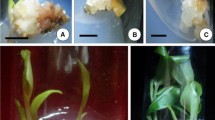Abstract
Callus culture has, to date, been reported only in a few species of Narcissus. We used anthers of Chinese narcissus (Narcissus tazetta L. var. chinensis Roem) as explants for callus induction and plant regeneration. A high percentage of anthers at the early- to mid-uninucleate microspore stage were responsive on the basal MS medium supplemented with 0.5–1 mg l−1 2,4-dichlorophenoxyacetic acid and 0.5–2 mg l−1 6-benzyladenine under dark conditions. Calli were initiated from anther connective tissue or anther wall tissue, and no division of microspores occurred during callus formation, as determined by histological observation. Using 20 random amplified polymorphic DNA primers, we verified the genetic integrity of the anther-derived plants of Chinese narcissus with respect to the donor plants. These results suggest that anther culture in vitro can provide an efficient new micropropagation technique for Chinese narcissus as well as a new strategy for in vitro mass propagation of other daffodils.



Similar content being viewed by others
Abbreviations
- BA:
-
6-Benzyladenine
- 2,4-D:
-
2,4-Dichlorophenoxyacetic acid;
- NAA:
-
α-Naphthaleneacetic acid
References
Arzate-Fernández AM, Nakazaki T, Okumoto Y, Tanisaka T (1997a) Efficient callus induction and plant regeneration from filaments with anther in lily (Lilium longiflorum Thunb.). Plant Cell Rep 16:836–840
Arzate-Fernádez AM, Nakazaki T, Yamagata H, Tanisaka T (1997b) Production of doubled-haploid plants from Lilium longiflorum Thunb. anther culture. Plant Sci 123:179–187
Dobson HEM, Arroyo J, Bergström G, Groth I (1997) Interspecific variation in floral fragrances within the genus Narcissus (Amaryllidaceae). Biochem Syst Ecol 25:685–706
Doyle JJ, Doyle JL (1987) A rapid DNA isolation procedure for small quantities of fresh leaf tissue. Phytochem Bull 19:11–15
Faure O, Aarrouf J, Nougarede A (1996) Ontogenesis, differentiation and precocious germination in anther-derived somatic embryos of grapevine (Vitis vinifera L.): Proembryogenesis. Ann Bot 78:23–28
Gu HS, Gao CH, Wang SF (1987) Plantlets regenerated from callus culture of Narcissus tazetta. Acta Bot Sin 28:336–339
Hanks GR (1986) Narcissus bulb morphology and twin-scale propagation. Acta Hortic 177: 309–314
Heberle-Bors E (1985) In vitro haploid formation from pollen: a critical review. Theor Appl Genet 71:361–374
Immonen S, Anttila H (1998) Impact of microspore developmental stage on induction and plant regeneration in rye anther culture. Plant Sci 139:213–222
Isabel N, Tremblay L, Michaud M, Tremblay FM, Bousquet J (1993) RAPDs as an aid to evaluate the genetic integrity of somatic embryogenesis-derived populations of Picea mariana (Mill.) B.S.P. Theor Appl Genet 86:81–87
Langens-Gerrits M, Nashimoto S (1997) Improved protocol for the propagation of Narcissus in vitro. Acta Hortic 430:331–334
Li MX (1980) Karyotype and Giemsa C-bands of Narcissus tazetta L. var. chinensis Roem. Acta Hortic Sin 7:27–35
Lin HX, Lin QY, Xie LH (1996) Narcissus virus and its progress. Plant Quarantine Sin 10:227–229
Moraes-Cerdeira RM, Burandt CLJ, Bastos JK, Nanayakkara D, Mikell J, Thurn J, McChesney JD (1997) Evaluation of four Narcissus cultivars as potential sources for galanthamine production. Planta Med 63:472–474
Murashige T, Skoog F (1962) A revised medium for rapid growth and bioassays with tobacco tissue cultures. Physiol Plant 15:473–479
Niimi Y, Han DS, Fujisaki F (2001) Production of virus-free plantlets by anther culture of Lilium × ‘Enchantment’. Sci Hortic 90:325–334
Prakash J, Giles KL (1986) Production of doubled haploids in oriental lilies. In: Genetic manipulation in plant breeding. Walter de Gruyter, Berlin, pp 335–337
Raimondi JP, Masuelli RW, Camadr EL (2001) Assessment of somaclonal variation in asparagus by RAPD fingerprinting and cytogenetic analyses. Sci Hortic 90:19–29
Rees AR (1969) The initiation and growth of Narcissus bulbs. Ann Bot 33:277–288
Sage DO, Lynn J, Hammatt N (2000) Somatic embryogenesis in Narcissus pseudonarcissus cvs. Golden Harvest and St. Keverne. Plant Sci 150:209–216
Salunkhe CK, Rao PS, Mhatre M (1999) Plant regeneration via somatic embryogenesis in anther callus of Vitis latifolia L. Plant Cell Rep 18:670–673
Santos J, Santos I, Salema R (1998) In vitro production of Narcissus bulbocodium flowering in the first season of growth. Sci Hortic 76:205–217
Seabrook JEA (1990) Narcissus (daffodil). In: Ammirato PV, Evans DR, Sharp WR, Bajaj YPS (eds) Handbook of plant cell culture. McGraw-Hill, New York, pp 577–597
Sellés M, Viladomat F, Bastida J, Codina C (1999) Callus induction, somatic embryogenesis and organogenesis in Narcissus confusus: correlation between the state of differentiation and the content of galanthamine and related alkaloids. Plant Cell Rep 18:646–651
Sopory SK, Munshi M (1996) Anther culture. In: Jain SM, Sopory SK, Veilleux RE (eds) In vitro haploid production in higher plants, vol 1. Kluwer, Dordrecht, pp 145–179
Squires WM, Langton FA (1990) Potential and limitations of Narcissus micropropagation: an experimental evaluation. Acta Hortic 266:67–76
Steinitz B, Yahel H (1982) In vitro propagation of Narcissus tazetta. Hortic Sci 17:333–334
Tuijia SA, Jana K, Hely MH, Leena AR (1999) Genetic fidelity of cryopreserved embryogenic cultures of open-pollinated Abies cephalonica. Plant Sci 142:163–172
van Tuyl JM, van Dien MP, van Creij MGM (1991) Application of in vitro pollination, ovary culture, ovule culture and embryo rescue for overcoming incongruity barriers in interspecific Lilium crosses. Plant Sci 74:115–126
Weniger B, Italiano L, Beck JP, Bastida J, Bergoñón S, Codina C, Lobstein A, Anton R (1995) Cytotoxic activity of Amaryllidaceae alkaloids. Planta Med 61:77–79
Xu PS, NiimiY, Araki H (2000) Production of virus-free bulblets from callus induced from scale culture of Lilium longiflorum ‘Georgia’ (in Japanese with English summary). J Jpn Soc Hortic Sci 69:97–102
Acknowledgements
We would like to thank Prof. Huiqiao Tian for his helpful suggestions on the experiments. The research was supported by Natural Science Foundation of Fujian province of China (No. F0210009)
Author information
Authors and Affiliations
Corresponding author
Additional information
Communicated by K. Kamo
Rights and permissions
About this article
Cite this article
Chen, L., Zhu, X., Gu, L. et al. Efficient callus induction and plant regeneration from anther of Chinese narcissus (Narcissus tazetta L. var. chinensis Roem). Plant Cell Rep 24, 401–407 (2005). https://doi.org/10.1007/s00299-005-0958-4
Received:
Revised:
Accepted:
Published:
Issue Date:
DOI: https://doi.org/10.1007/s00299-005-0958-4




